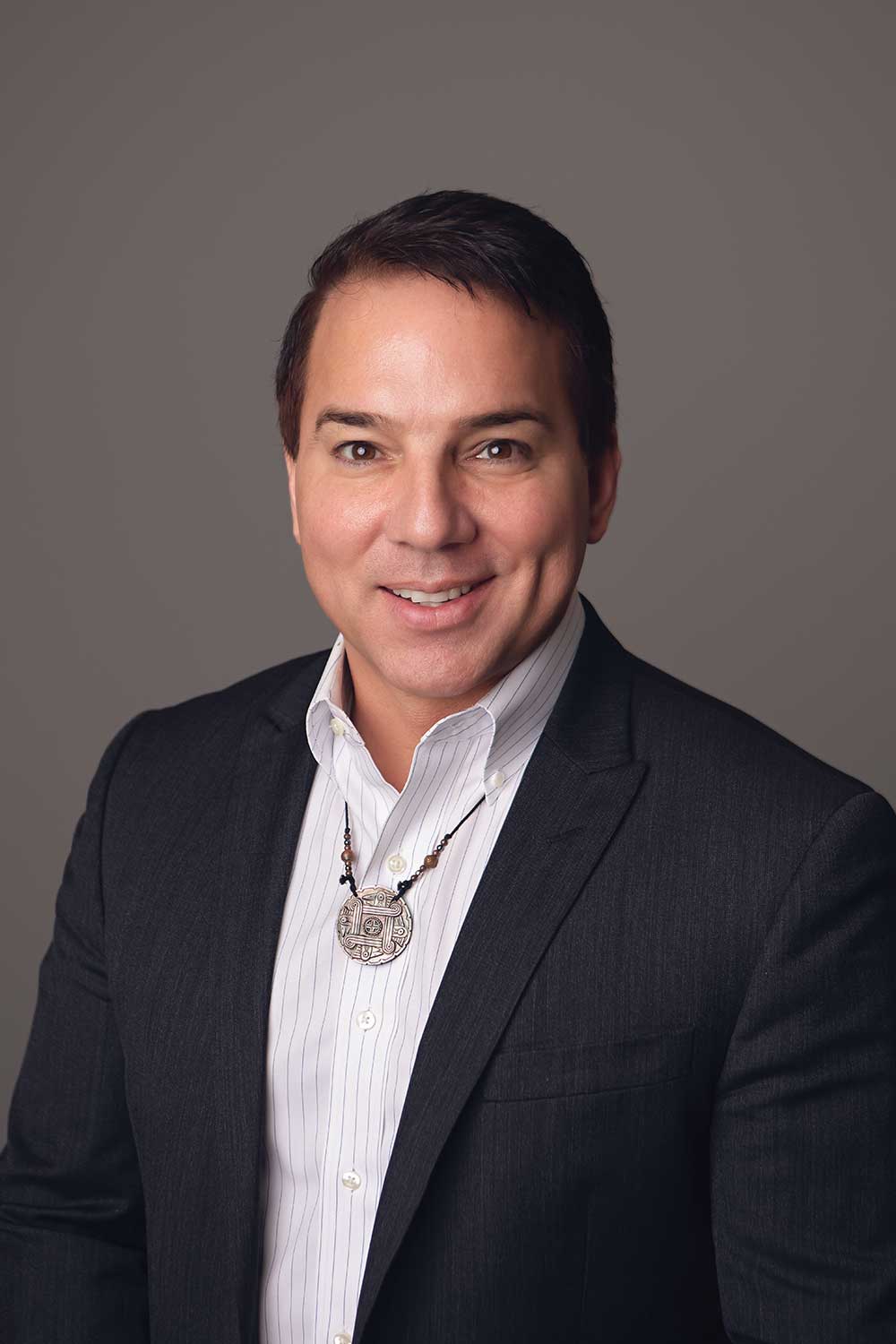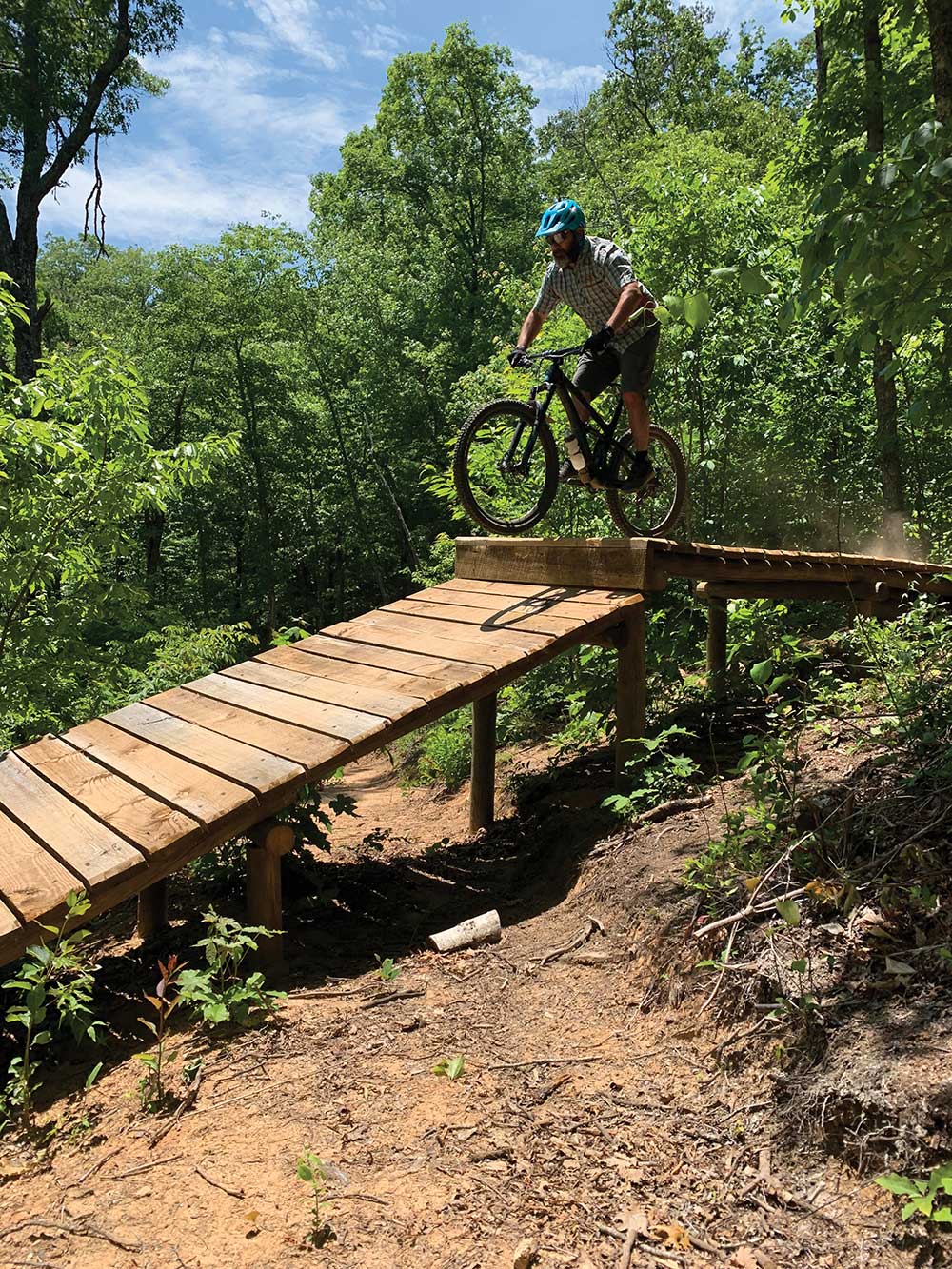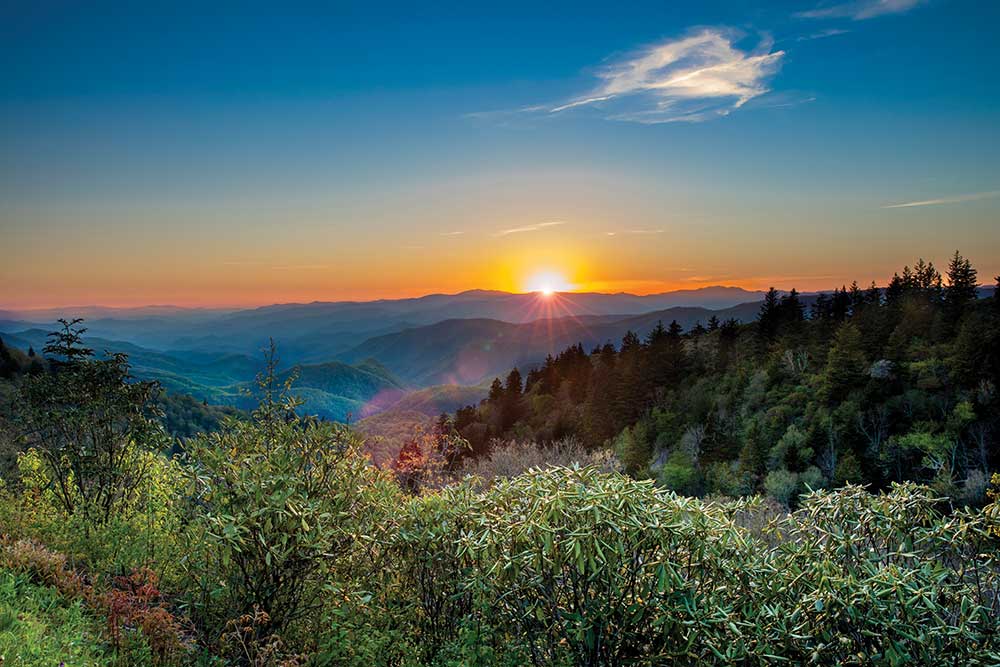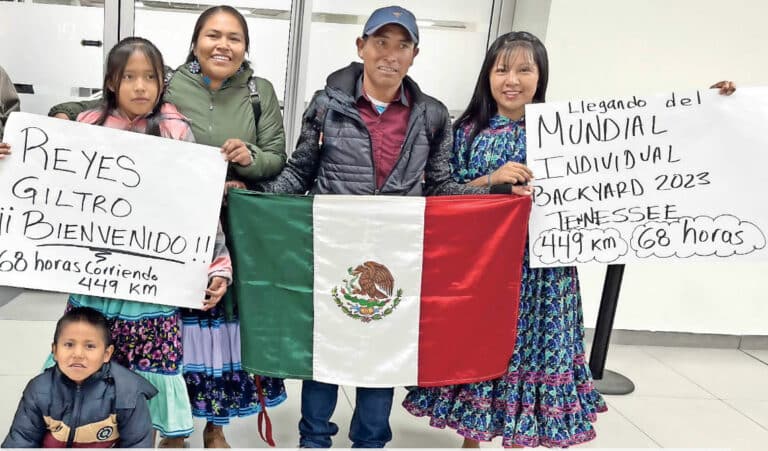Principal Chief Richard Sneed is turning Cherokee, North Carolina, into a mecca of outdoor recreation—and he’s doing it using traditional tribal values.
The winter afternoon brings spring-like temperatures and Richard Sneed, principal chief of the Eastern Band of Cherokee Indians, aims to capitalize on the reprieve. He shuts his office door and trades his coat, tie, white oxford shirt, and dress shoes for red bike shorts, a matching cycling jersey, and mountain biking shoes.
Hopping on his Specialized Stumpjumper, Sneed, 51, pedals a quick 1.5 miles across town to the tribe’s 3-year-old Fire Mountain Bike Park. There, he proves a formidable rider.
Sneed crushes the 1.8-mile ascent up the Uktena climbing trail like a man half his age. Along the way, we pass through jangly rhododendron thickets and stands of towering oaks and cross sturdy wooden bridges over mossy, boulder-strewn gullies and gurgling mountain streams. Reaching the 2,927-foot summit, Sneed contemplates a horizon of cloud-enwrapped peaks in Great Smoky Mountains National Park.

“That’s what brought me home,” he says, referring both to the landscape and his 20s—most of which was spent living on military bases throughout the U.S. “Whatever’s happening in my life, I can look out on these mountains and it just calms me to the core.”
Seconds later, Sneed noses into Kessel Run, the 12-mile system’s flagship trail. The one-way, double-track route is rated black diamond and brings nearly 2,000 feet of vertical descent. With dozens of tabletops, rhythm sections, 10-foot berms, and numerous wooden features, it’s a fast and flowy rollercoaster built for highspeed fun. Sneed launches jumps and whips around berms at an impressive pace.
“How cool is it we have this right in our backyard?” he says at the bottom, breathing heavily, his face plastered in a boyish grin. “I mean, you can bike here in less than 15 minutes from pretty much anywhere in town, ride world-class trails, and it’s totally free. How many other [non-resort] municipalities can say that?”
Sneed became principal chief in 2016 and quickly pushed the installation of Fire Mountain, which was completed the following year for about $250,000. He framed the park as a pilot for a broader initiative to diversify the tribal economy through ecotourism and inspire residents to be more active.
“At first, we had some trouble getting everyone on board,” says Sneed.
Tribal members—elders, in particular—were wary of opening cherished lands to outsiders. Many feared visitors “would come in and trash things up.”
Shifting the perception was tough. Sneed and others had to convince hardliners to take what, to them, seemed a dangerous gamble.
Sneed’s argument was three-pronged. First, ecotourists tend to respect the land and follow an ethos of no-trace-left-behind. Second, convenience and cultural amenities would make Cherokee an ideal destination for adventurous families. Third, visiting riders would invariably discover other offerings—like hiking in the 56,000-acre backcountry, or kayaking and trout fishing in the crystal-clear waters of the Oconaluftee River.
The reasoning proved sound: Fire Mountain was an incredible success. While economic impact studies are still forthcoming, secretary of administration, Jeremy Hyatt, says outside visits to Fire Mountain have been estimated at about 20,000 per year.
The influx has helped bring new businesses to Cherokee, including a bike shop, outdoors store, and its first locally owned brewpub. Hoteliers say bike-related bookings have increased substantially and, in some cases, necessitated renovations. River outfitters have developed additional kayaking and tubing offerings. Restaurants have built new patios and bar areas, added pizza ovens, and expanded menus to include more craft beers on tap, regional wines, and locally sourced ingredients. Demand for the latter has led small-scale farmers to invest in boosting production. The list goes on.
“Our local business owners love Fire Mountain, and I mean love it,” says Hyatt. “Its success has fundamentally changed the way they think about tourism.”
The support has helped Sneed secure funding to expand Fire Mountain. In 2019, $150,000 was generated for 1.5 miles of new trail and wooden features—including drops, gaps, skinnies, wall rides, and a summit gazebo. A lease for an adjacent 140 acres followed earlier this year. There, the tribe will build a sister park that Sneed says will be “at least as big as Fire Mountain, but potentially much larger.”

The goal? To make Cherokee the Southeast’s biggest, most attractive non-resort ride center.
But Sneed’s outdoors overhaul is about more than just mountain biking. His administration plans to invest in other experiences as well. Ideas include more hiking trails and walk-in campsites in the backcountry; a large-scale rock climbing and bouldering facility; zipline adventure course; trout hatchery; and more.
“Richard’s genius lay in the way he foresaw the benefits of all this, but refused to just plow ahead,” says Hyatt. “He was very patient. He emphasized the need for an overwhelming consensus.”
The strategy gave the community time to adjust, take ownership of the vision, and adapt it as their own.
Sneed says his passion for the initiative stems from a deep love of the area’s natural beauty. But his approach derives from outside perspective.
“I grew up on the Jersey Shore with my mom,” explains Sneed. As a kid, weekends and afternoons typically found him riding his BMX bike to the beach, through local neighborhoods, or at jump tracks. “I was a BMX punk, 100 percent. I wore earrings and big baggy jeans, had long hair, the whole nine yards.”
At 14, though, Sneed relocated to Cherokee to live with his dad.
“Culture shock is an inadequate phrase,” he laughs, recalling his arrival. “It was a totally different world; I didn’t know what to do with myself.”
Relatives and classmates introduced Sneed to a lifestyle centered around nature and the outdoors. He soon fell in love with hiking and camping in the woods, fishing in crystalline waterways, and the like.
Still, he had no intentions of staying. Following high school, Sneed enlisted in the Marines, where he became a certified automotive mechanic and met his future wife. The couple married and spent a decade base-hopping around the country. They moved from Kansas City to Cherokee in the mid-1990s.
“The older I got, the more I craved its woods, mountains, and streams,” says Sneed. “The pull was magnetic. Eventually, I realized this was where I wanted to settle down and raise a family.”
Initially, making it was tough. Prior to the arrival of Harrah’s Resort Casino in
1997, poverty was rampant. Sneed found work as a contract mechanic, then a high school teacher in the vocational department. Though the casino brought jobs and financial prosperity, it bothered him that most visitors never left the premises. To him, they were missing out.
Throughout the 2000s, Sneed became increasingly interested in tribal politics. He made his first bid for public office in 2015 and was elected vice chief. Ten months later he was promoted, following the impeachment of principal chief, Patrick Lambert. Sneed quickly came to view pursuing economic development through ecotourism as a signature initiative.
He says the most attractive thing about the approach is how it inherently promotes an active lifestyle and an ethos of stewardship that is “traditionally very Cherokee.”
“I see it as a paradigm shift,” says Sneed. “This mode of thinking is going to carry us into the future and help transform this amazing place into something all the more magical. And best of all, we’re doing it in a manner in keeping with our tribal identity and values.”








